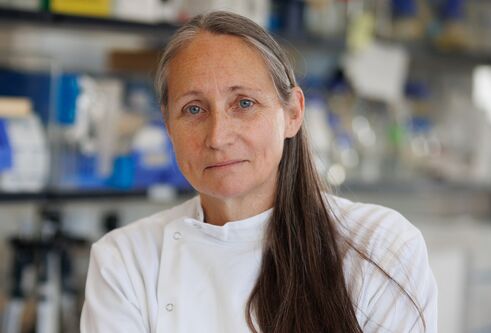Professor Kate StoreyFRS FRSE FMedSci FRSB
Chair of Neural Development
Molecular Cell and Developmental Biology, School of Life Sciences
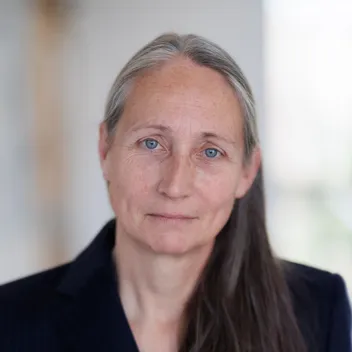
Contact
Biography
Kate Storey is Chair of Neural Development in the School of Life Sciences. Her research focusses on cellular and molecular mechanisms that regulate neural differentiation, most recently using human pluripotent stem cell derived neural tissue assays.
Kate has a Neurobiology degree from the University of Sussex (1983) and a PhD, with Michael Bate FRS, from the University of Cambridge (1987). She undertook post-doctoral research on a Harkness fellowship at the University of California, Berkeley with David Weisblat and at the University of Oxford with Claudio Stern FRS. She took up a lectureship at the University of Oxford (1994) and moved to the University of Dundee (2000) with an MRC senior non-clinical fellowship. She became head of the Division of Cell and Developmental Biology in 2010.
Kate is known for the discovery of the fundamental signalling switch that controls neural differentiation in the developing embryo, and a cell biological mechanism, apical abscission, which mediates the differentiation of newborn neurons.
Kate is a fellow of the Royal Society, EMBO, the Royal Society of Edinburgh, and the Academy of Medical Sciences. She was awarded the MRC Suffrage Science Heirloom Award 2014, Royal Society Wolfson Research Merit Award 2015, and British Society for Developmental Biology’s Waddington Medal in 2019.
University Roles
Kate served as Associate Dean of Research (2008-2010) and co-led the School’s successful BBSRC Impact with Excellence Award 2011. She was head of the Division of Cell and Developmental Biology for 12 years (2010-2022) and subsequently co-head of the merged Division of Molecular, Cell and Developmental Biology for ~ 1 year. She was one of four senior faculty responsible for the School of Life Sciences UoA5 REF submission 2014. With Dr Lindsay Davidson, Kate established a human pluripotent stem cell facility (2015) which supports research using these cells across the University and beyond.
Kate is currently academic lead with oversight responsibilities for the School of Life Sciences Human Pluripotent Stem Cell Facility. She also serves as the University of Dundee’s Academy of Medical Sciences Champion, with Miratul Muqit.
External Roles
Kate has served on grant panels for Wellcome, MRC Neuroscience and Mental Health Board, BBSRC panel A, Dorothy Hodgkin Fellowships Panel, University Research Fellowships Panel for the Royal Society, Lister Institute Prize Scientific Advisory Board, Action for Medical Research, membership committees for EMBO and Royal Society of Edinburgh, and Scientific Advisory Boards including the MRC Centre for Neurodevelopmental Disorders and HDBI management group. She was a director of the Company of Biologists for 14 years, co-establishing their International Workshop series and developing sustainability and ethical investment initiatives.
Currently, Kate is Vice-chair of the Human Developmental Biology Resource (HDBR) steering committee (2018 - present). This tissue bank operates under the Human Tissue Act and has ethics approval to collect, store and distribute human embryonic and foetal tissue for medical research. A contributor to Nuffield Council On Bioethics initiative on recommendations for research with human neural organoids. She is Co-chair for HDBI ethics seminars. A member of the Roslin Foundation Grants Advisory Committee and Royal Society Fellowship Search Committee 8 and Research Professorships Panel.
Research
Researchers in Kate Storey’s laboratory investigate how the nervous system forms during embryonic development.
We all come from a single cell, the fertilised egg. As this cell divides to generate the embryo individual cells begin to specialise in a process known as cellular differentiation. We wish to understand how neural cells arise in the embryo and how their differentiation is controlled.
The spinal cord is generated progressively as the embryonic body is laid down and this helps us to identify and investigate the distinct steps that underlie its formation. This includes when and how neural precursor cells stop dividing and become nerve cells, and how nerve cells then change shape and ultimately make connections to form functional neural circuitry.
We have used a wide range of techniques, including gain and loss of gene function approaches and genome-wide analyses, as well as live imaging assays, which allow us to monitor changes in cell behaviour during differentiation. Most recently, we have used human pluripotent stem cell derived neural tissue assays, allowing us to investigate human embryonic development.
Our overall aim is to discover cellular and molecular mechanisms that control neural differentiation. Elucidating these mechanisms helps us to understand how the developing nervous system is impacted by cellular stress and may inform strategies for therapeutic treatment of neural injury and disease.
Outlines of our research projects addressing how developmental signals interact and direct chromatin organisation to regulate neural differentiation progression, how signals and cell biological mechanisms control generation of new nerve cells, and how neural cells mature and respond to injury and cellular stress can be found on the Storey lab website.
Current collaborative projects include functional analysis of intellectual disability genes in human in vitro neural tissue assays with Dr Greg Findlay (MRC PPU), and how exposure to extreme heat and associated cellular stress impact placental and embryonic development with Dr Colin Murdoch (School of Medicine), as well as collaborations with colleagues in Wellcome’s Human Developmental Biology Initiative (HDBI).
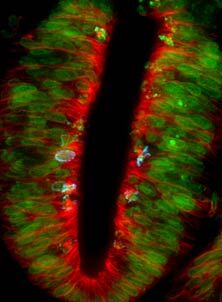
People in My Lab
Second Supervisor:
- Sophie Rappich, Wellcome (with Dr Greg Findlay, MRC PPU)
- Amy Dunne Miller, MRC-DTP (with Dr Sourav Banerjee, School of Medicine)
- Namanpreet Kaur, (with Dr Greg Findlay, MRC PPU)
as well as Master’s and Honours students
The Human Pluripotent Stem Cell Facility
- Dr Lindsay Davidson (Manager)
- Dr Margarita Kalamara (Research Assistant)
- Mr Adam Hetherington (Technician)
For further information about the facility check their webpage.
Selected Publications
A complete publication list can be found using my ORCID 0000-0003-3506-1287
- Rodrigo Albors, A., Singer G.A., May, A.P., Ponting, C.P. and Storey, K.G. (2023) An ependymal cell census identifies heterogeneous and ongoing cell maturation in the adult mouse spinal cord that changes dynamically on injury. Developmental Cell 2023. Feb 6;58(3):239255.e10. doi:10.1016/j.devcel.2023.01.2023 PMID: 36706756 Read Article
- Semprich, C.I., Davidson, L., Amorim Torres, A., Patel H., Briscoe, J., Metzis, V., and Storey, K.G. (2022). ERK1/2 signalling dynamics promote neural differentiation by regulating chromatin accessibility and the polycomb repressive complex PLoS Biology Dec 1;20(12):e3000221.doi: 10.1371/journal.pbio.3000221. PMID: 36455041 Read Article
- Poncet N., Halley P.A., Lipina C., Gierliński M., Dady A., Singer G.A., Febrer M., Shi Y.B., Yamaguchi T.P., Taylor P.M., Storey, K.G., (2020) Wnt regulates amino acid transporter Slc7a5 and so constrains the integrated stress response in mouse embryos. EMBO Reports 21(1) doi/10.15252/embr.201948469 PMCID 6944906 PMID 31789450 Read Article
- Verrier, L., Davidson, L., Gierlinski, M., Dady, A., Storey, K.G., (2018) Neural differentiation, selection and transcriptomic profiling of human neuromesodermal progenitors-like cells in vitro. Development, 145(11). doi/10.1242/dev.166215 PMCID 6124542 PMID 29899136 Read Article
- Kasioulis, I., Das, R. M., Storey, K.G., (2017) Inter-dependent apical microtubule and actin dynamics orchestrate centrosome retention and neuronal delamination. eLife. doi/10.7554/eLife.26215 PMCID 5653239 PMID 29058679 Read Article
- Olivera-Martinez, I., Schurch, N., Li, R., Song, J., Halley, P.A., Das, R.M., Burt, D.W., Barton, G.J., Storey, K.G., (2014) Major transcriptome re-organisation and abrupt changes in signalling, cell cycle and chromatin regulation at neural differentiation in vivo. Development, 141: 3266-3276 doi/10.1242/dev.112623 PMCID 4197544 PMID 25063452 Read Article
- Das, R. M., Storey, K.G., (2014) Apical abscission alters cell polarity and dismantles the primary cilium during neurogenesis. Science. 343, 200-204. doi/10.1126/science.1247521 PMCID 4066580 PMID 24408437 Read Article
- Stavridis, M. S., Lunn, J.S., Collins, B.J. and Storey K.G. (2007) A discrete period of FGF/Erk1/2 activity is required for vertebrate neural specification. Development 134, 2889-94. PMID: 17660197. Read Article
- Diez del Corral, R., Olivera-Martinez, I., Goriely, A., Gale, E., Maden, M., and Storey, K (2003) Opposing FGF and Retinoid pathways control ventral neural patterning, neuronal differentiation and segmentation during body axis extension. Neuron 40, 65-79. PMID: 14527434. Read Article
- Brown, J.M., and Storey, K.G. (2000). A region of the vertebrate neural plate in which neighbouring cells can adopt neural or epidermal cell fates. Current Biology 10, 869-872. PMID: 10899008. Read Article
Public Understanding of Science
The Storey group share their research with the public in a variety of ways, from school workplace experience and summer vacation studentships in the lab to School of Life Science and University open days for the public as well as contributions to science festivals.
One way in which Kate Storey and members of her group reach a wider audience is through collaboration with artists Read more. This includes collaborative Science-Art projects with her sister Helen Storey (University of the Arts London).
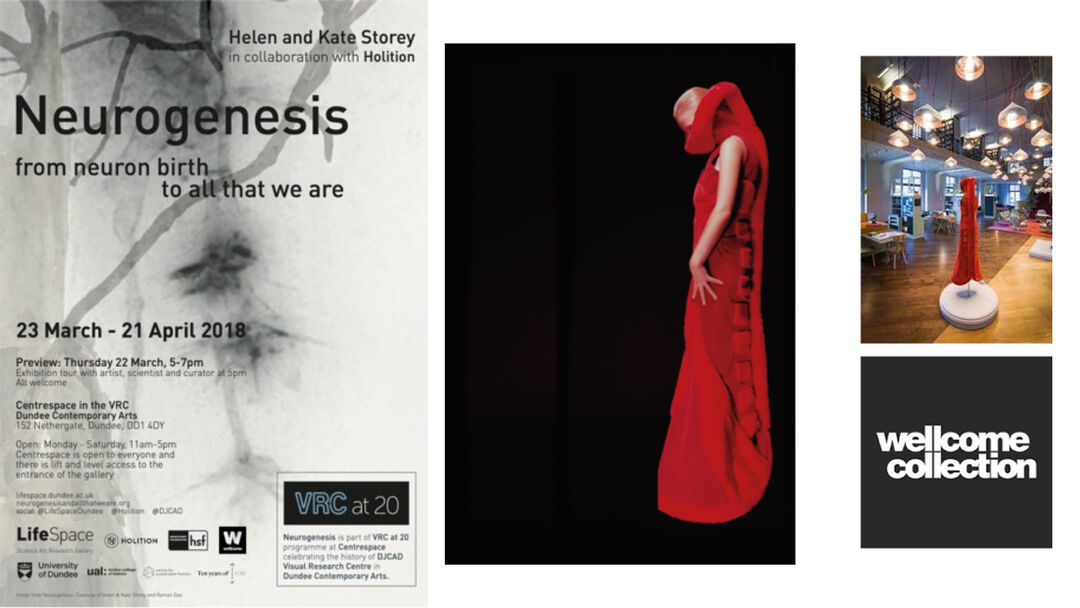
Left: Poster from exhibition on Neurogenesis, the birth of new neurons – created by Kate and Helen Storey in collaboration with digital design company Holition. Right: Red neurulation dress, designed by Helen and Kate Storey, part of the Primitive Streak collection, on public display at the Wellcome Collection reading room, London.
Science Art projects
- Primitive Streak
- Woman’s hour Kate & Helen Storey talking about their collaboration
- Neurogenesis
Teaching
Contributes lectures to:
- Stem Cells in Development and Disease – year 4
- Cell Biology of Disease – MSc Res
Supervision:
- Honours student final year projects
- Graduate student supervision
- Master’s student supervision
Project development discussions:
- Art, Science & Visual Thinking module DJCAD/SLS
- Undergraduate & master’s students
Awards
| Award | Year |
|---|---|
| Fellow of the Royal Society | 2022 |
| National Sciences Prizes awarded since 1990 / British Society for Developmental Biology Waddington Medal | 2019 |
| Fellow of the Academy of Medical Sciences | 2017 |
| Member of the European Molecular Biology Organisation | 2016 |
| National Sciences Prizes awarded since 1990 / Royal Society Wolfson Research Merit Award | 2015 |
| National Sciences Prizes awarded since 1990 / MRC Suffrage Science Heirloom Award | 2014 |
| Major Personal Funding Awards / Wellcome Trust Senior Investigator Award | 2013 |
| Fellow of the Royal Society of Edinburgh | 2012 |
| Fellow of Learned Societies and Colleges / Fellow of the Royal Society of Arts | 2011 |
| Fellow of the Royal Society of Biology | 2011 |
Stories
News
Kate Storey is stepping down from co-leadership of the Division of Molecular, Cell and Developmental Biology (MCDB). Jens Januschke will join Tom Owen-Hughes as joint divisional lead.
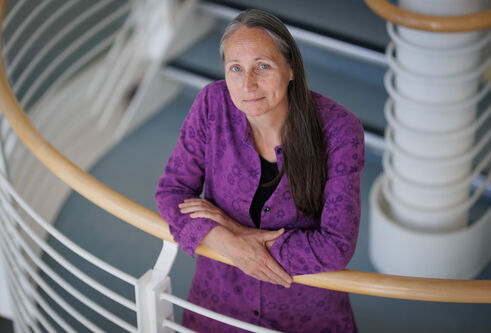
News
An international collaboration led by scientists at the University of Dundee has discovered one potential roadblock to spinal cord regeneration in humans.

Press release
Professor Kate Storey, of the University of Dundee, has been elected a Fellow of the Royal Society (FRS), the world's oldest scientific academy in continuous existence.
